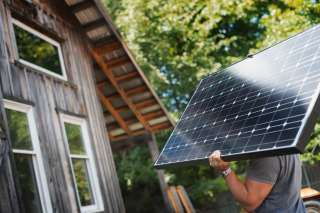Are Home Solar Panels Worth the Cost? Here’s When They Make Sense—And When They Don’t

With prices falling rapidly, installing home solar panels can dramatically trim your energy bills -- if you do your homework ahead of time.
Residential photovoltaic systems -- the type of solar panels that produce electricity -- could cost more than $50,000 a decade ago. New technology has sent prices plummeting more than 60% in the past several years.
Today, the average upfront cost of a six-kilowatt solar panel system -- one of the common sizes for residential homes -- runs between $16,260 and $21,420, according to per-watt estimates from energy marketplace EnergySage. And that's before you factor in generous tax credits.
While the technology has become more affordable, that doesn't necessarily mean a system is right for your home. Reducing or eliminating energy bills sounds attractive, but, depending on your situation, the cost may not be worthwhile. Here are important questions to ask yourself to decide if pursuing home solar panels is right for you:
How much does energy cost where you live?
Nobody likes paying energy bills, but some states have it worse than others. Massachusetts residents pay 21 cents per kilowatt hour, or about 70% more than the national average, according the U.S. government, while those in Kentucky pay less than 10 cents per kilowatt hour, or about 20% below.
The upshot: Based on average amount of energy U.S. households use, it would take about 20 years to defray the upfront cost of a typical $21,000 residential solar system in Kentucky. In Massachusetts, however, the system would recoup its cost after just a decade.
“It's all about how much your cost is, how much you're paying versus the grid,” says Tom Kimbis, the executive vice president of the Solar Energy Industries Association.
Does your state offer home solar panel financial incentives?
Homeowners who buy their panels -- instead of leasing them -- can claim a federal tax credit worth 30% of their purchase cost come tax season, a $6,000 return on a $20,000 home solar system. One caveat: Your taxable income must be greater than the 30% credit amount to reap the full benefit, according to a TurboTax. The good news, however, is that taxpayers can rollover any unused credit for future years.
Depending on where you live, that’s not the only way to shave the cost of a home solar panel. Fourteen states and Puerto Rico offer their own tax credits or deductions. New York, for example, adds an additional 25% personal tax credit for home solar panels. You can see what your state offers on dsireusa.org, a database run by the NC Clean Energy Technology Center at North Carolina State University.
Is your roof optimal for solar panels?
Even if you live in a state with high electricity costs and extra financial incentives, home solar panels might not be for you if certain environmental factors aren’t there. Sunlight is the most obvious, and homes with good south, southwest or southeast exposure in sunny states will generally produce more energy than solar panels in darker areas or facing the wrong direction. Additionally, a good roof for solar panels is unobscured by shadows from dormers, chimneys or trees, says Ben Delman, communications director at Solar United Neighbors, a Washington, D.C.-based advocacy group, and should measure at least 200 square feet.
You can get a good idea of how much sun your state gets at Energy.gov and check how popular solar panels are in your state at SEIA.org, which breaks the number of homes powered by solar panels and solar companies down by state.
Should I get home solar panels?
Depending on your location, you may be able to get an overall estimate of your potential home solar panel savings at google.com/sunroof. Google's calculator uses Google earth data, weather patterns and information about your average monthly electric bill to calculate your potential home solar system's energy savings, optimal size, upfront cost and environmental impact.
Of course, don't forget to check for local rules regarding solar panels, since some neighborhoods restrict or even ban them.
Ready to press forward? Contact at least three to four solar companies certified by the North American Board of Certified Energy Practitioners for estimates, says Delman. You can find installers by going to nabcep.org's installer locator, selecting your state and searching for solar PV installers.